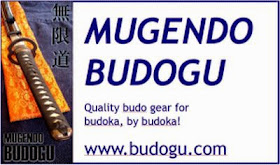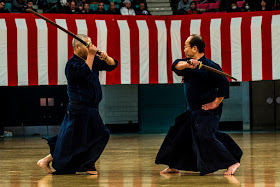 |
| Ono-ha Itto Ryu. Photo Copyright 2015 Grigoris Miliaresis |
The movie hero studies and studies to learn the secret technique that will make him unbeatable (why is it always “he?”). The secret strike or trick that the foe can’t stop. We love secret techniques and hidden wisdom. Legions of movies and books are built on the premise that somewhere, somehow, there is a secret that will make the possessor unbeatable. Many budo systems are said to have been created when the founder had a sudden inspiration or even a divine revelation into the special use of their weapon.
Many of us started martial arts looking for that secret. The heros in kung fu and karate movies had to have some secret that made them so incredible. From the power of Iron Fist in Marvel Comics to the secret balancing training in The Karate Kid, the secret teaching brings power, and that is really attractive. The secrets of Katori Shinto Ryu are said to have been handed down to it’s founder by the kami Futsunushi No Kami, enshrined at Katori Shrine. The secrets of Shinto Muso Ryu are said to have been revealed to it’s founder in a dream by a divine child.
Many classical Japanese ryuha protect their secrets and won’t let outsiders see them practiced. Shinto Muso Ryu has 5 secret kata that are only taught to the highest level of student and are never shown to anyone else.
This makes sense. An opponent cannot defend against what she doesn’t know about. Surprise attacks work. Attacking with something your opponent can’t imagine is coming is a wonderful tactic. I can see why a secret technique would be useful. The premise is very appealing. One set of techniques that you show to the world, another set held in reserve to maintain the power of secrecy.
Secret techniques sound fascinating and mysterious, but they aren’t usually what win. Throughout the Tokugawa period (1604-1868), the most popular systems of kenjutsu were the various branches of Itto Ryu. There were Itto Ryu dojos all over Japan, and especially in Tokyo. The Tokyo dojo were significant for the spread of knowledge about Itto Ryu, because all of the daimyo and many of their servitors spent 6 months of the year in Tokyo. Their children were raised there. People could and did meet and train in dojo throughout the city.
The techniques and strategies of the Itto Ryu branches, particularly Ono-ha Itto Ryu, were well known and widely practiced. Yet this does not seem to reduced the effectiveness of the style. Ono-ha Itto Ryu may well have been the most practiced school of kenjutsu by the last half of the Tokugawa period. Not having a secret doesn’t seem to have cut into it’s popularity.
If secret techniques have so much power, why would a school like Itto Ryu, where the basic strategy and technique is well and widely known and recognized be so popular? The answer to that is simply that it was effective in the gekiken competitions that were increasingly popular. In that environment, Itto Ryu technique worked well.
In the 21st century, Ronda Rousey competes in an unarmed combat venue similar in nature to the gekiken sword competitions of 18th and 19th century Japan. She may be the epitome of not having a secret technique. Even before she entered MMA fighting, she fought in judo competitions. Throughout that time, she never had a secret technique. There are no secret techniques in judo or MMA. The nature of the rules mean that all the possible techniques are known.
Secret techniques have a significant flaw. They only maintain their special power so long as they are secret. As soon as you use a secret technique where it is seen, everyone will study it, know that you do it, and figure out how to defeat it. The power of a secret technique, like any secret, vanishes when it becomes known.
Ronda Rousey doesn’t have a secret technique. Everyone knows what she’s going to do. She’s going to attack an arm lock. Most likely, she will be attacking what is known to judoka as jujigatame. Even though everyone knows what she will do, for some reason they still can’t prevent it. It’s not a secret technique. It’s the opposite of a secret technique. It’s a specialized technique, and it works wonderfully.
The same was true of the signature technique of Ono-ha Itto Ryu. Everyone knew what the Itto ryu practitioner would do. Their signature cut is still famous and the basis of modern kendo technique. Everyone knows what Ronda Rousey is going to do. It’s a classic judo technique.
These techniques are powerful, and they are polished. That makes them stronger over the long run than any secret technique. Secret techniques lose their power quickly from the moment they cease to be secret. Special techniques don’t lose anything by being known. They may even benefit from being widely known. Everyone knows what Rousey is going to do. She’s going to do jujigateme. So everyone spends a lot of time trying to figure out how to stop her jujigatame. Everyone who faces an Ono-ha Itto Ryu swordsman knows what she will do. She’s going to cut straight down the center, right through your defense. If you want to face someone with a special technique, you have to spend your time figuring out how to stop it.
The corollary is that when you spend all your time learning to stop someone’s special technique, that leaves you vulnerable to all of the other things they can do not quite as well as their special technique. Their special technique makes all their other techniques more effective. Itto Ryu opponents are worried about losing to kiri otoshi. When they focus on defending against that, they open themselves up to the other techniques in the Itto Ryu curriculum. Rousey’s foes focus on stopping her arm locks, which makes her perfectly sound striking and throwing techniques all the more effective.
Secret techniques won’t carry us very far. Their very nature makes their power and effectiveness short lived. Once a secret technique is known, it loses it’s power. Highly polished special techniques on the other hand, maintain their power even after they become well-known. For someone like Ronda Rousey or a student of a system like Itto Ryu, the very notoriety of their special technique can be asset, because it makes people focus on the special technique and neglect the rest of their repertoire.
The lesson in all of this is an old one. Kano Jigoro Shihan was famous for saying that the secret to success in judo is “Practice. Practice. Practice.” That hasn’t changed. Practice your entire art, but polish your special technique. Practice it and practice it. Make it shine so bright it obscures the effectiveness of the rest of your techniques.
9/30/2015 Special thanks to Meik Skoss for a correction on the Itto Ryu terminology.






